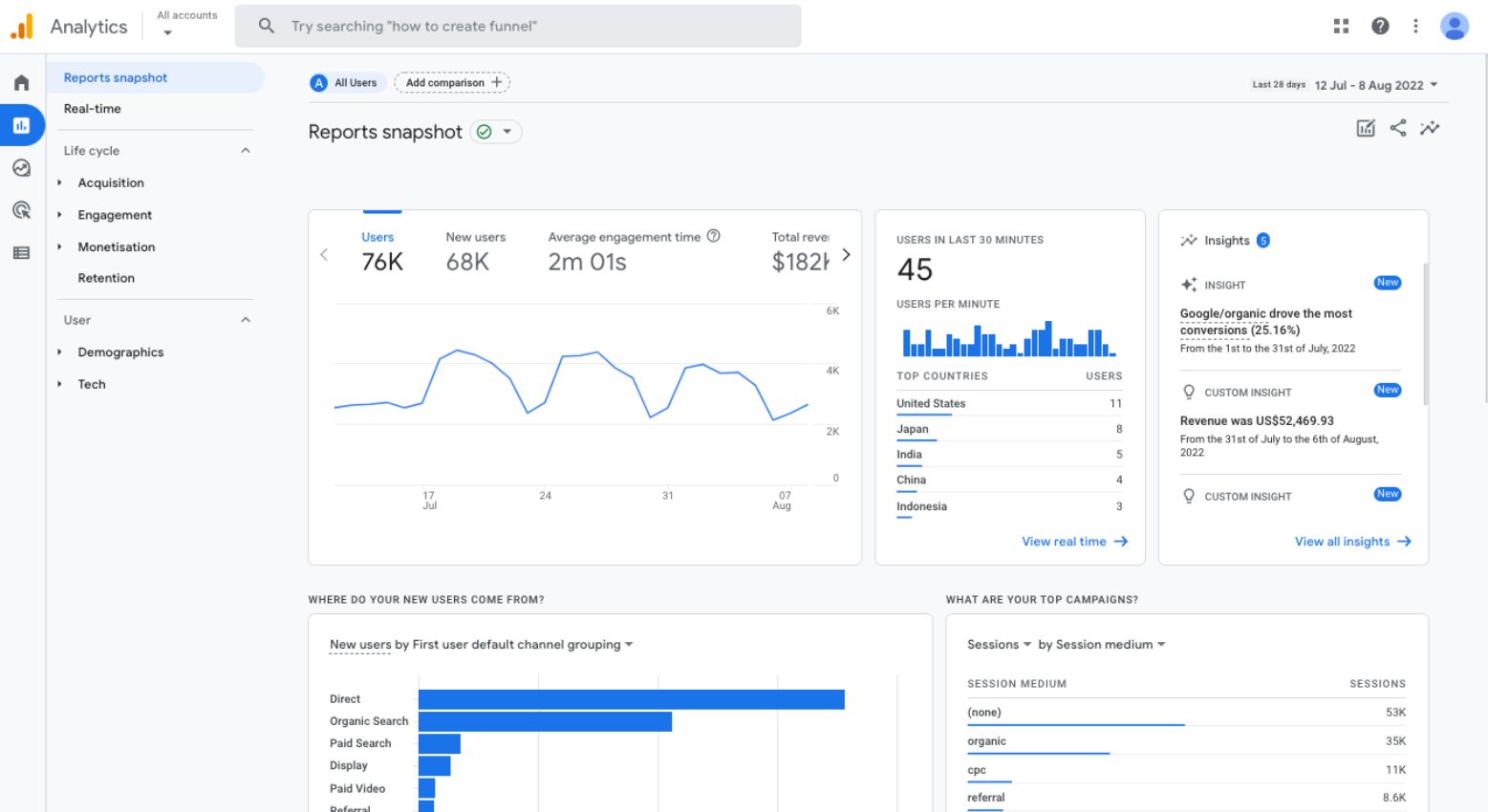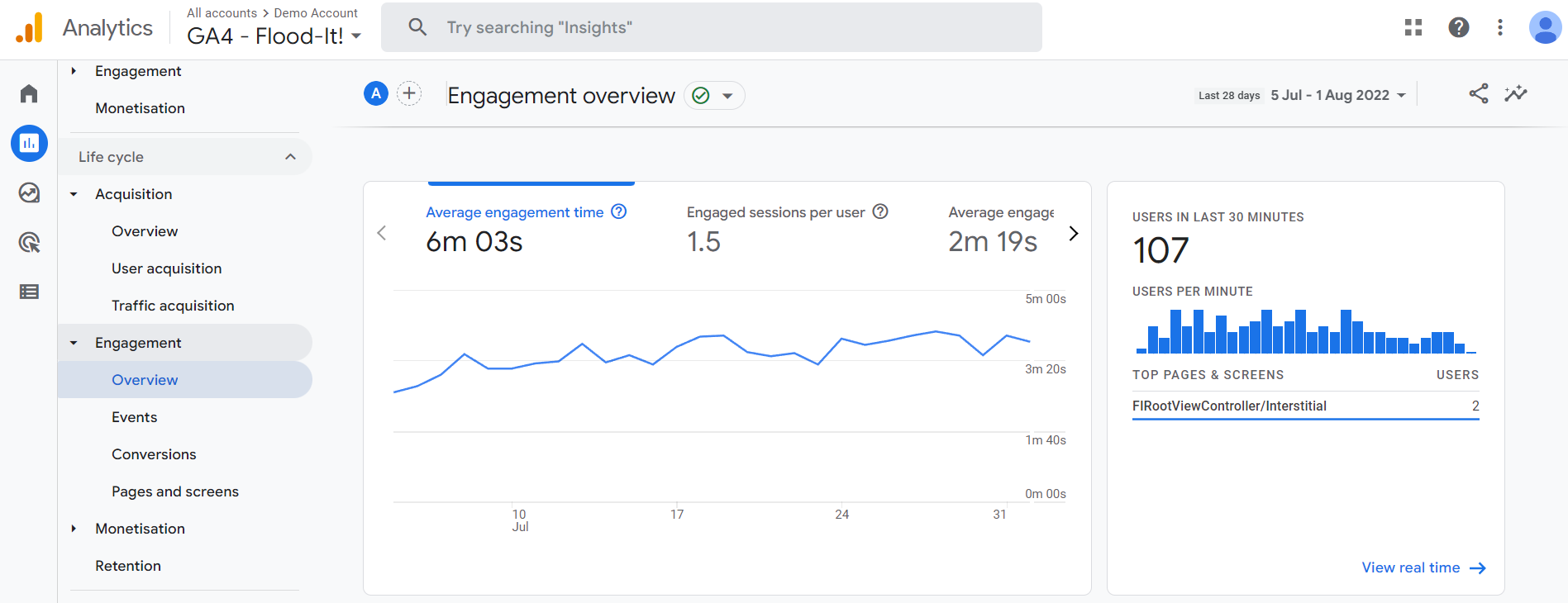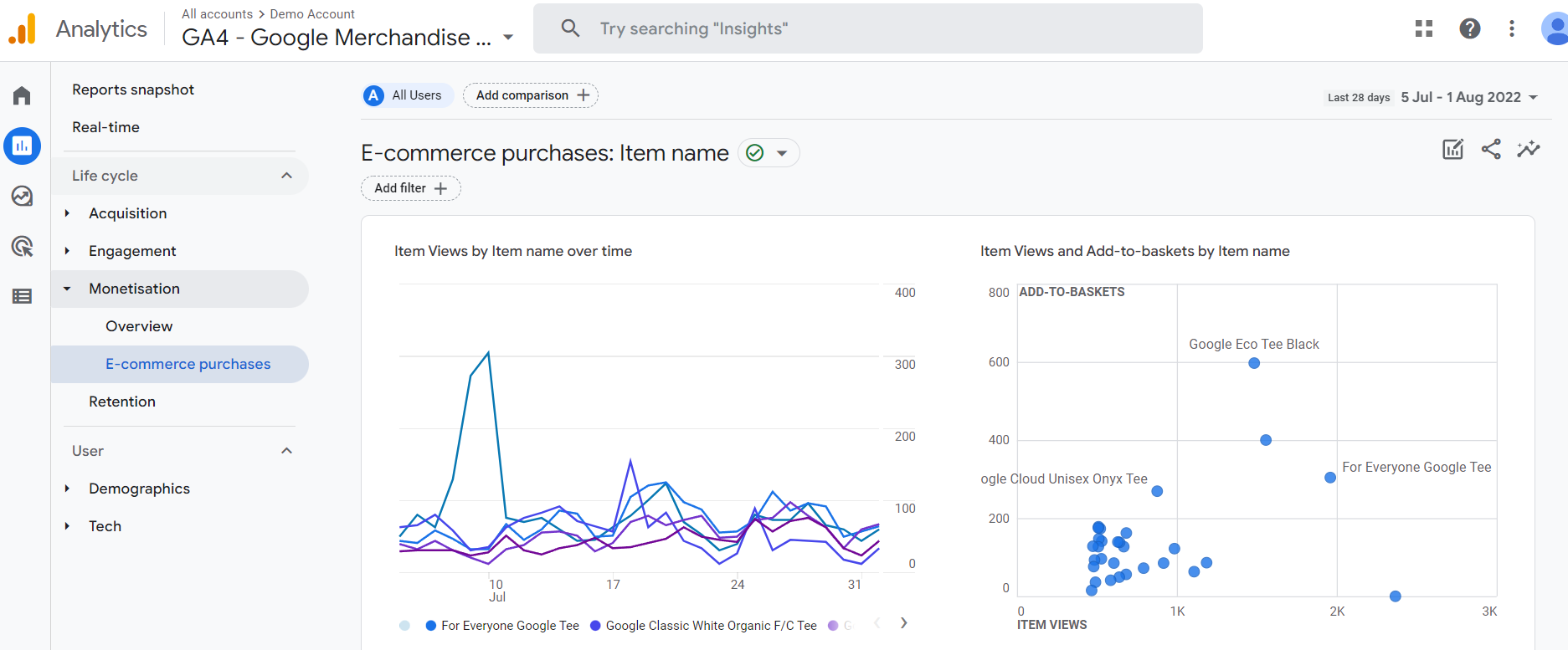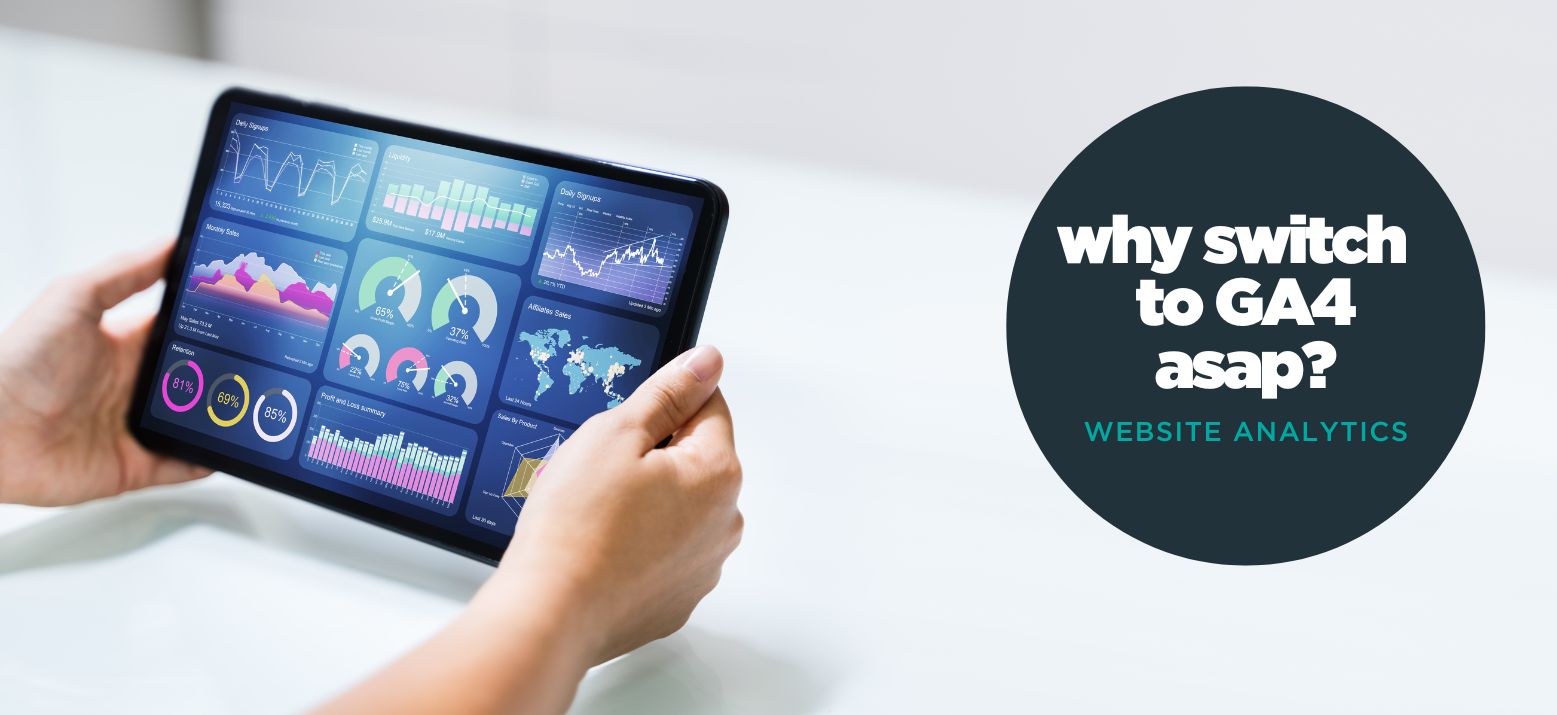Anyone who regularly logs into their website’s Google Analytics account can’t have failed to see the notifications and prompts that have been appearing for months now from Google – about moving your Universal Analytics (UA) account over to a new GA4 property, with a warning that your data won’t be processed in standard UA from July 2023.
You’d be forgiven for thinking that means you have virtually a year to make the move to GA4 and can stick it on the ‘think about this in a few months’ pile. But taking some steps now with GA4 could actually make a big difference to the data available to you when standard UA is ‘sunsetted’ next year.
In this guide, we take a look at GA4, how it’s different to UA, why it’s important to migrate ASAP, when the deadlines are, and how to make sure you migrate to the new version effectively.
Jump to:
- What is GA4?
- Why is GA4 important?
- What are the deadlines for switching to GA4?
- How is GA4 different to UA?
- 10 steps to migrate to GA4 stress-free
What is GA4?

Google Analytics 4 (GA4) is the latest major release of Google’s website tracking platform and will soon be the default version, with new site data no longer being captured and stored in the standard version of the previous platform, Universal Analytics (UA), once the deadline has passed.
Websites using Analytics 360 (the paid version of Google Analytics) will also need to switch over to a GA4 property.
If your free Google Analytics property was set up before around October 2020, it will most likely be UA. If your analytics property was set up after this, you could well already be using GA4.
GA4 will only be able to collect data from the point that the property is created, which means that historical data from previous analytics versions cannot be imported to it, and other steps need to be taken to ensure that useful historical data and insights are not lost with the switch. We will cover this later in the guide.
Why is GA4 important?
At a very top-line level, Google Analytics tells you who is visiting your website, how they got there and what they are looking for. However, it goes so much further than that and can provide a very in-depth look at website performance, marketing performance, content performance, audience analysis and what your customers really need from your online presence.
These insights show how your website impacts on your business objectives and should inform future digital strategy to get even better results. Missing out on all of this insight can be potentially very damaging for businesses as they won’t be able to base their strategy on a good sample size of data.
So, making the switch to GA4 is important for a few reasons. The primary one is that if you currently use UA, analytics data will simply not be collected in this account after the 2023 deadline, so you won’t have access to any of the insights and benefits that this brings.
Another reason why GA4 is important is that it provides certain features and tools that are different to what has been offered before (covered later in this guide) and gives many additional possibilities for using this website data to better measure online performance, understand your audience and act on the insights provided to grow your business.
GA4 is also important because it changes some of the ways that user data is collected and stored to ensure it doesn’t compromise the privacy protection of users. With privacy and data security a real concern for many people and different laws applying to different countries and regions for things like cookie collection and notifications, GA4 helps to futureproof website analytics data.

What are the deadlines for switching to GA4?
- For those using UA currently, data will not be collected after 1st July 2023 in any UA property.
- For those using Analytics 360, there is a one-time processing extension until 1st October 2023 to make the switch.
- It is expected that historical data in these old properties will be able to be accessed for up to six months after the deadlines above, but no new data will be collected from those dates.
As the data in GA4 only starts from the point that it is set up, doing so as soon as possible means that you will have more historical data to utilise, even if you don’t rely fully on GA4 straight away – so when July 2023 comes, you’ll have that lovely ‘year on year’ data that us marketers love.
You can continue collecting data with UA over the next few weeks and months as you transition fully to GA4. More on this later!
How is GA4 different to UA?
While UA and GA4 are both analytics platforms from Google, they are actually fundamentally different in the ways that they collect and analyse data from websites.
UA is a tool that enables data collection, storage, analysis and reporting all in the same place and using just the one single interface. However, GA4 is designed to be paired with other Google tools to deliver all of this functionality and more. These other tools include Google Tag Manager and Google Data Studio.
There are also some changes to terminology in GA4, so some metrics are called different things, or some terms are the same but have a slightly different meaning.
This can make things a little complex if trying to match up certain results or metrics in both platforms, or with historical data that you have exported from UA.
Mobile and web data is more closely integrated in GA4, with a more uniform data model used than in UA. The reporting elements of GA4 allow lots of customisation, but you can also export raw data into Google BigQuery for additional functionality and to combine it with other data sources, along with using Google Data Studio for building client or stakeholder-facing reports.
This means that using GA4 is going to take a bit of getting used to for many people and the sooner you start to familiarise yourself with it, the easier the transition should hopefully be. Leaving things until just before the data cut-off deadline is a recipe for stress!

10 steps to migrate to GA4 stress-free
OK, so we can’t actually promise that migrating from UA to GA4 will be totally stress-free, but along with some planning and preparation, we believe that these tips should help you to have as straightforward a migration as possible.
1. Audit your UA property first
You won’t be able to set up GA4 effectively without understanding fully how your UA account is currently structured and configured.
This means you need a clear view of what data you’re collecting now and how you are using this information. You should:
- List the metrics you track in UA
- List how those metrics are used now in your performance analysis and reporting
- List any KPIs that you track which are related to UA metrics to make sure nothing is missed
- List the other systems and tools that you connect to your UA account e.g. Google Search Console, Google Ads, Google Data Studio etc.
- List any customisations that you use in your UA property and why they are used e.g. events, custom segments, content groupings etc.
- List any dashboards you have set up and what they show
- List your goals and any associated information so these can be tracked in GA4 too
- List any ecommerce tracking actions that you are monitoring in UA
- List any issues or quirks with your UA property that you want to fix with GA4 e.g. uses the incorrect currency or time zone
2. Set up your GA4 property alongside UA
You can add a GA4 property to your website using Google’s own GA4 set-up guide and add in the data stream(s) that you want to be included i.e. Web, iOS app, Android app. This will start collecting data at the same time as your UA property still functions normally.
3. Add GA4 tracking to all pages using Google Tag Manager (GTM) and create event tags as needed
There is a good guide by Google for doing this.
4. Connect GA4 to the same systems and tools that you use with UA
Use the list that you made during your UA audit to ensure that the same tools and systems are connected to your new GA4 property so that you can replicate some of the data you use in UA.
5. Convert your UA goals to GA4 conversion events
Check that the names and labels for your UA goals mean the same thing in GA4 to ensure that you’re tracking the right things. GA4 uses the term ‘conversion events’ to cover a wide range of different types of on-site action. There are many recommended events to choose from but you may need to create an enhanced measurement in GA4 to replicate some UA goals.
6. Set up ecommerce tracking in GA4
Gathering shopping behaviour data can be invaluable if you sell products and services on your website, so ensure it’s set up properly with Google’s guide.
Things may look quite different with GA4 to how it looks under UA, so it’s important to understand how to view the information that is important for your business.

7. Compare your UA metrics to the GA4 options after 4-6 weeks of data collection
Due to the fundamental differences in how some of the data is gathered in GA4, you will usually spot some differences in the ways thing are measured, which is why comparing a good few weeks of data directly with your concurrent UA metrics will help you highlight these issues and find ways around them to get the data you want.
8. Check and tweak GA4 settings and customisations as you go
GA4 isn’t the finished article yet. There are frequently new features being released so it’s important to stay on top of this and carefully monitor your GA4 settings and customisations while you still have the UA data to compare it against. Data can only be used for insight and planning if you know that it’s as accurate as possible.
9. Export your historical data from UA on 30th June 2023/1st July 2023
Importing your historical data from UA into GA4 isn’t possible, as the data collection models are too different.
However, you can export the raw data from UA on the final day that it collects data and this can be fed into Google BigQuery so that you can use it as part of your analysis and planning into the future. Whether it’s checking seasonal or trend data, comparing new performance to old or seeing growth over a longer time period than you have access to in GA4, there are lots of reasons why exporting this data can be useful.
Google don’t make it particularly easy to do this in bulk, so you’ll need to set aside some time to plan exactly which data and reports you want to export, as well as time to manually export them.
10. Train your team in using GA4
It might feel like a tough ask to train anyone from your team who regularly uses site analytics when you’re just getting used to it yourself, but it’s essential to make sure that people can find the information they need and understand what they are viewing.
Some areas that you might find most useful to cover in training sessions include:
- Explaining new vocabulary and any metrics that have different names in GA4
- Explaining any dashboard changes and how to run common data queries that the team use frequently
- Explaining any metrics that have changed because the data is collected in a different way now, and what the new equivalent is
Google has a collection of helpful guides and online training for GA4 that could be useful to share with the team too.
Migration to GA4 isn’t something that can be boxed off in a day. There is a planning process that needs to happen to be sure that you’re not going to miss vital data in the new platform, and even when the bulk of the migration work is done, there are still elements that need to be regularly checked to ensure that accurate data is pulling through in the right ways for your business requirements.
Taking these steps as soon as you can means that you have the best chance of transitioning to GA4 with the minimum of stress and maintaining as much continuity of data as possible throughout the process.
If you’re concerned about switching to GA4 or want advice on any area of your SEO strategy, we can provide support to help with the process, along with other SEO insights that could help shape your strategy and reporting. Get in touch with the team using the form below.








